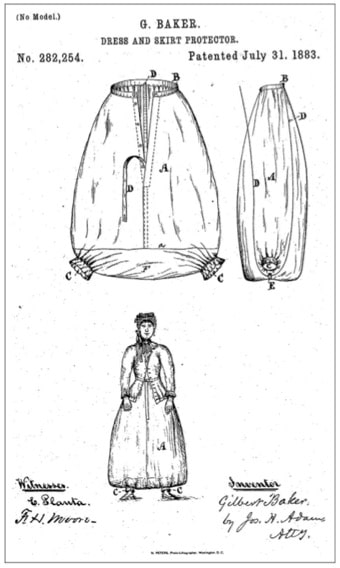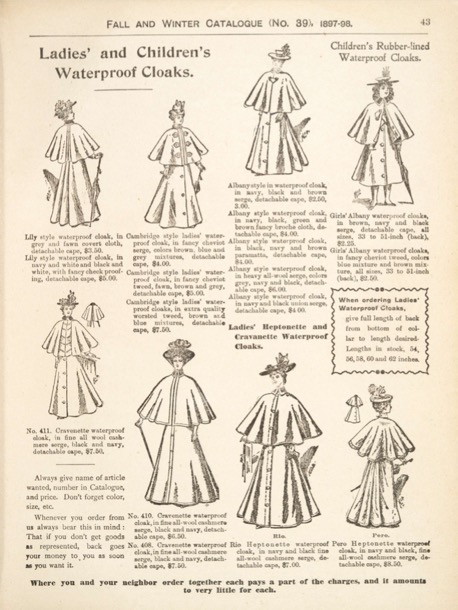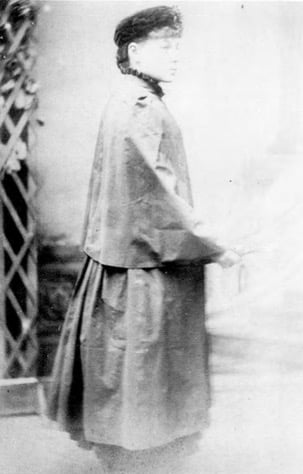Sophia Zweifel, 2017 Isabel Bader Fellow in Textile Conservation and Research
One of the textiles we have selected to study from the Queen’s University Collection of Canadian Dress is a linen “duster jacket” dated approximately to the 1870s (figure 1). Duster jackets were worn while riding or travelling to protect lower layers of clothing from dust and soiling. However, there is little known about this particular jacket in the collection. It is quite an elegant jacket, cut long and loose with pagoda-like sleeves that create a caped effect around the back. The full length of the centre front is fastened with flat wooden buttons covered with the same linen that makes up the jacket. The edges of the sleeves as well as the neck are trimmed with elegant pleating. The jacket’s stitching was all done by machine, but in a chain stitch, characteristic of early sewing machines. These details of construction help situate the garment in a particular period.
When we came across it, we noted what appeared to be a heavy, somewhat lustrous finish on the surface of the linen. This was of particular interest for our project, and we were really keen to find out what the finish might be. If the jacket was simply starched, and the lustre was created just by the heat and pressure of ironing, then it wouldn’t reveal too much additional information about the piece. However, we were curious whether other substances might be present that would have acted as waterproofing agents. When viewed under UV light, we could see that the finish around the top of the garment had been disturbed, by what looked like rain. We also noted that there were some original repairs on the jacket (which were very well executed!), and that the finish had been applied after the repairs were done. This indicated to us that the finish had been applied in the household, as a part of the jacket’s regular maintenance, and was not merely an industrial coating applied during the manufacturing of the fabric. We set out to analyse the finish in hopes that it would offer some added insight into the intended function of the jacket when worn.
In the meantime, I did some research into 19th-century waterproofing methods. Due to the voluminous skirts of dresses and coats worn in this period that often dragged along the ground, as well as the delicate and sensitive luxury fabrics that were often used, there was a high demand for waterproofing solutions to keep these underlying layers of fabric clean and dry. There were some outrageous patents filed for skirt protectors that involved lifting skirts with cords or straps and securing them within rubber protectors cinched around the wearer’s ankles (figure 2). These were too unstylish and impractical to catch on, and even the more stylish skirt protector solutions that conformed to the fashionable silhouettes of the time did not become popular.[1] However, waterproof jackets had been adopted since Charles McIntosh first discovered a method of applying rubberized coatings to fabrics in 1823.[2] The “mackintosh” or “mac,” as rubber-lined cloaks came to be called, did not become fully practical until the 1840s after the discovery of the vulcanization process for rubber, which prevented the coats from becoming rigid in the cold and sticky and odorous in heat.
By the 1880s, many mackintoshes were being designed for women, in fashions very similar to that of the duster jacket in the Agnes collection. The cape or “mantle” feature of the mackintosh coats was highly functional as it prevented water from entering at seams or fastening points, and encouraged water to run off the body of the wearer. This style endured for some time even in Canada, and we can find similar cuts of waterproof cloaks in the Fall and Winter Eaton’s Catalogue from 1897–1898 (figure 3). In an 1884 image of a woman wearing one of the latest mackintosh designs (figure 4), we see a frilly collar, similar to the pleated trim of the duster jacket’s collar, that became a common feature of women’s mackintoshes. We can also see in the image the stiff “hand” (texture, or drape) of the rubber-lined textile, offering us a good tactile sense of what these waterproof garments were like. This image leads me to wonder if the duster jacket in our collection, likely made by a local dressmaker, was designed to be of a similar style to these waterproof coats. Despite their popularity, actual mackintoshes remained relatively expensive. The linen duster jacket’s relative simplicity, as well as the fact that it is unlined, suggest that it may have been made for a middle-class woman. It is not unlikely that some women during this period would have opted to have less expensive coats made for them, and that they chose to apply alternative waterproofing coatings to the fabric themselves.

Dress and skirt protector, adapted from Baker (1883). Reprinted in Arlesa J. Shephard, Waterproof Dress: Patents as Evidence of Design and Function from 1880 Through 1895, Clothing and Textiles Research Journal 30.3 (2012): 190.

Ladies’ and Children’s Waterproof Cloaks for sale in Eaton’s Fall and Winter Catalogue, 1897–1898.

Registered design for a mackintosh by Joseph Mandleburg & Co., 1884. Reprinted in Sarah Levitt, Manchester Mackintoshes: A History of the Rubberized Garment Trade in Manchester, Textile History 17.1 (1986): 60.
It soon became clear in my research that Victorian housekeepers or housewives were not afraid to try out different waterproofing “recipes” and apply them to their clothes.[3] While there were numerous patents for industrial methods of waterproofing fabrics[4] (which involved not only the application of rubberized coatings, but also the chemical precipitation of insoluble metal soaps on the fabrics), there were also a number of common household methods and materials that could be applied.[5] The simplest methods involved rubbing beeswax all over the fabric and passing an iron over it to fuse the wax to the surface, or mixing different waxes, resins, rosin soaps, or even adhesives such as isinglass, with hot linseed oil, and then brushing the mixture over the fabric. Some more complex recipes mimicked industrial methods by adding metallic compounds such as alum, iron, or even lead oxide to the mixture, so that the metal ions would form insoluble metallic soaps with the fatty acids present in the rest of the mixture. These domestic recipes were a true feat of household chemistry, and were complemented by the housekeeper’s knowledge of how to clean and care for these finished garments so as to prolong the lifespan of these coatings.
The analysis of the finish on the duster jacket was really interesting. Examination by polarized light microscopy revealed that both starch as well as an unknown material were present on the surface of the fibres. We set out to use further analytical techniques in an attempt to identify the unknown components of the finish. First we tried to identify it using FTIR (Fourier transform infrared spectroscopy), a method that reveals the molecular make-up of materials by the characteristic adsorption of different chemical bonds and functional groups. Using minute fibre samples and working under a microscope, I attempted to scrape the finish from the fibres of the sample using a scalpel, and then did an FTIR reading of the finish scrapings. Unfortunately, there were still too many linen fibres present to be able to detect anything other than the linen by this method. Next, I tried dissolving the finish from the fibre sample onto a microscope slide by placing it in a drop of acetone. The fibre was then removed and the acetone evaporated from the slide, leaving a residue of finish behind. This finish was then successfully analysed by FTIR, generating a spectrum similar to that of an alkyd. With the help of Scott Williams and his skills interpreting FTIR spectra, this spectrum gave us an idea of what might be present in the finish (perhaps a linseed oil, or a type of wax). However, further analysis needed to be done if we wanted a more conclusive identification.
We sent fibre samples to the Canadian Conservation Institute for analysis by GC-MS (gas chromatography-mass spectrometry) and Py-GC-MS (pyrolysis-gas chromatography-mass spectrometry). Thread samples from both the highly finished outside of the jacket as well as from within an open seam were analysed for comparative purposes. It was found that significant amounts of starch, beeswax, tallow wax, and Pinaceae resin (a component of 19th-century rosin soaps) were present on the outside of the jacket, whereas only starch and trace amounts of beeswax and Pinaceae resin were found on the inside of the open seam.[6] This indicated that while the textile had been treated with starch overall, the wax coating had been applied to the outside surface of the jacket after manufacture, and was likely not part of the fabric’s industrial coating. This, in combination with the observation of the finish coating over original repairs, indicated to us that the coating had likely been applied within the household as part of the jacket’s maintenance, perhaps on a regular basis. The wax mixture found in the finish suggests that the finish was likely intended to be a waterproofing agent. The 19th- and early 20th-century practical receipts I read offered some insight into how this finish may have been applied: perhaps the wax was simply rubbed on the jacket’s surface and infused with a hot iron.
We feel that the analysis of the duster jacket’s finish was a great success, as it helped us understand another aspect of the jacket’s use, as well as the history of its care and maintenance. The jacket would have served its purpose as a “duster” well, keeping the dust and particulate soiling off the wearer’s underlying clothing (during our examination we found iron particulates on the jacket, indicative of the industrial air of the period to which the jacket would have been exposed). However, we now know of the additional finishing efforts put into the jacket by a fastidious housekeeper or owner, in the hopes of simply keeping its wearer dry while out in the rain.
[1] Arlesa J. Shephard, “Waterproof Dress: Patents as Evidence of Design and Function from 1880 Through 1895,” Clothing and Textiles Research Journal 30.3 (2012): 183–99.
[2] Sarah Levitt, “Manchester Mackintoshes: A History of the Rubberized Garment Trade in Manchester,” Textile History 17.1 (1986): 51–70.
[3] Christina Walkley and Vanda Foster, Crinolines and Crimping Irons. Victorian Clothes: How They Were Cleaned and Cared For (London: Peter Owen, 1978), 37.
[4] Stanilus Mierzinski, The Waterproofing of Fabrics, translated by Arthur Morris and Herbert Robson (London: Scott, Greenwood & Son, 1914).
[5] Albert A. Hopkins, ed. The Scientific American Cyclopedia of Receipts, Notes, & Queries, 25th edition (New York: Munn & Co., 1906).
[6] Jennifer Poulain, Conservation Science Division, “Analysis of a Coating on a Dust Jacket for Agnes Etherington Art Centre, Kingston, Ontario Canada,” Canadian Conservation Institute, Report No. CSD 5413, CCI 129866, 6 April 2017.